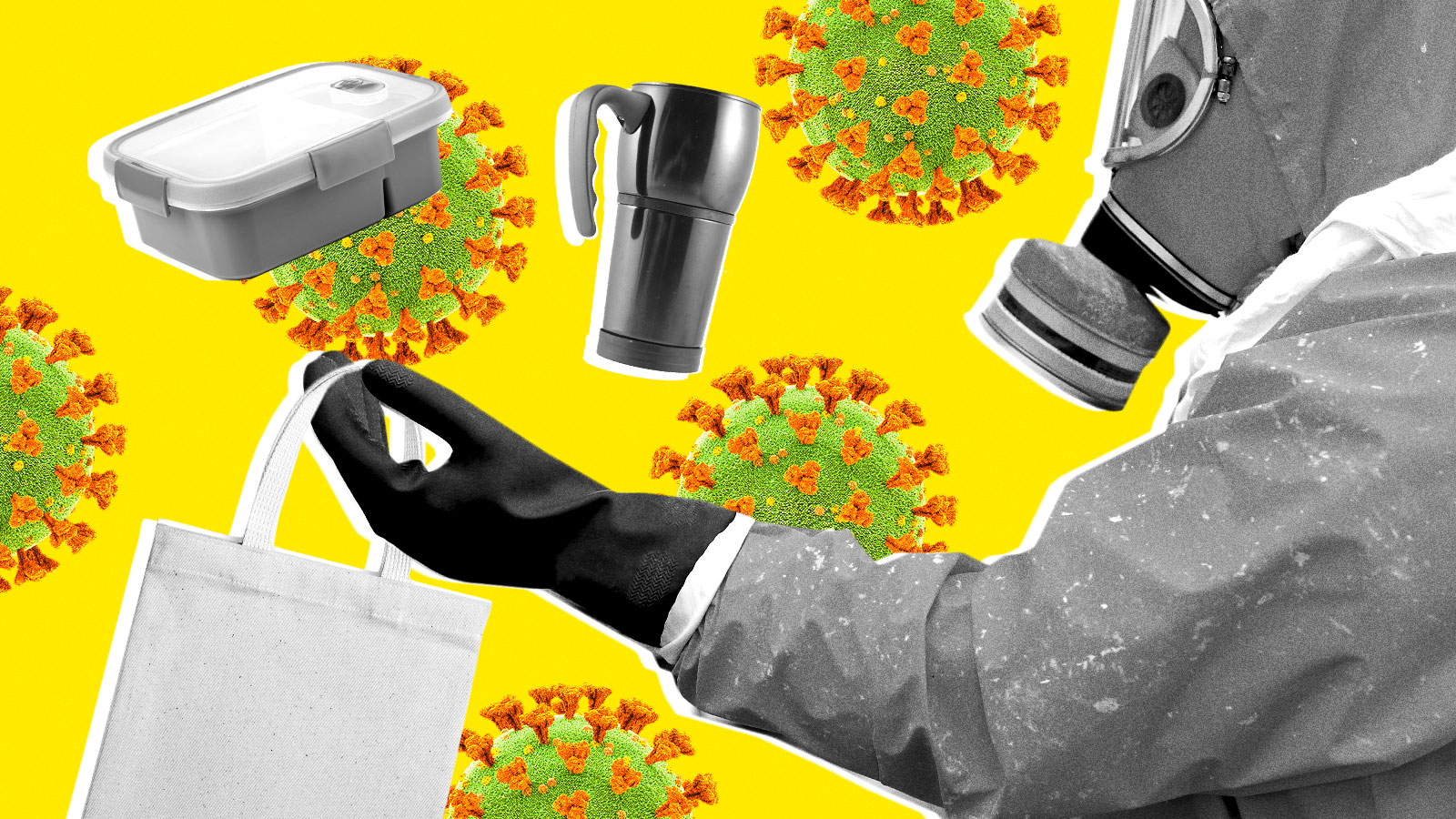It’s official: It�
That secondhand side-eye doesn’t just apply to coffee containers. Given the rapid, worldwide spread of COVID-19 — the severe respiratory disease caused by this new coronavirus — all manner of reuse habits that just a few months ago might have been considered environmentally virtuous now invoke the same kind of germaphobic fear response as a public coughing fit. Renting clothes so you don’t have to buy new ones that you’ll only wear once or twice? Rent the Runway updated its frequently asked questions last week to reassure concerned customers that “there is currently no evidence that COVID-19 can be transmitted from soft surfaces like fabric or carpet to humans.” Shopping with a reusable bag to avoid single-use plastics? A local news station in Buffalo ran a segment warning viewers to wash or disinfect their bags between each use, citing research showing that a completely different type of virus can be transmitted from reusable bags to other parts of a grocery store via shoppers’ hands.
Reusing goods and packaging as many times as possible, instead of disposing of them and then buying new ones, is one of the greenest practices there is. It prevents energy and resources from being spent on manufacturing and shipping new stuff. It diverts old stuff from landfills and oceans. These facts are at the heart of the so-called zero-waste movement, which has spawned books, blogs, and package-free stores in recent years.
And there have been promising recent signs of a burgeoning “circular economy” — that is, a no- or low-waste system that encourages reuse rather than disposal. ThredUp, an online secondhand clothing store, grew from receiving 4 million clothing items for resale in 2014 to 21 million in 2018. In 2019, fast-casual chain Just Salad says it diverted 75,000 pounds of plastic from landfills with its $1 reusable bowls, which customers wash at home and then bring back to be filled with salad again. Last May, Terracycle launched Loop, an online store that sells groceries and household items in reusable packaging that shoppers return to Loop once they’re empty in exchange for a deposit.
But can the circular economy continue to grow during what some epidemiologists are already calling a pandemic? Reusable or secondhand items are unlikely to spread the novel coronavirus, as long as they’re washed or disinfected in between uses. But new items come with an aura of cleanliness, while reusable and secondhand goods often fight the perception of being unsanitary. The key to encouraging reuse at a time when coronavirus infection numbers are rising might be recognizing that neither stereotype is true.
“No disposable package is today sterile, just to be explicitly clear,” said Tom Szaky, the founder and CEO of TerraCycle in an interview with Grist. Different kinds of disposable packaging have different microbial limits set by independent standard-setting organizations — and unless a product is explicitly marked sterile, none of those limits are zero. That means a certain level of bacterial contamination is considered acceptable and inevitable.
Take a disposable plastic bottle, Szaky said. “That bottle is going to be moving through a bottle plant. It’s going to be put onto a pallet. That whole process is being touched and dust is being collected on it,” he said. “In no way should you take the message from me that a disposable package is dangerous … It’s just not surgically sterile and not even close.”
For Béa Johnson, the author of Zero-Waste Home, one of the founding texts of the zero-waste movement, the hygienic uncertainty in the supply chain is one reason she prefers a reusable water canteen to disposable water bottles. “With disposables, you have no idea who has touched it. With your own reusables, you do!” she wrote in an email to Grist. “Being afraid of reusables is as ridiculous as being afraid of Corona beer,” Johnson added.
So why do we tend to think of plastic packaging as being sanitary when it’s not? Szaky traces that idea to the 1950s, when the oil industry first introduced disposable plastic packaging and goods. “Disposability brought about unparalleled affordability and convenience. Moving from a plate you had to wash — probably by hand, because there weren’t even dishwashers then — to a disposable plate you could throw away was massively liberating and also very cheap,” Szaky told Grist. “And I think what ended up happening is people got this misperception that wrapping something in plastic also made it more sanitary.”
Loop’s circular model is aimed at doing away with the stereotype that packaging has to be disposable to be sanitary. Szaky emphasized that the process of rewashing Loop’s reusable packaging is “at the most sophisticated level washing can be.” The cleaning facility “looks like a silicon wafer factory,” he told Grist.
But Vineet Menachery, an assistant professor of microbiology at the University of Texas Medical Branch, says that level of sophistication isn’t necessary to prevent the spread of coronavirus. Depending on temperature and humidity, coronaviruses can survive on hard surfaces like steel or plastic for two to nine days — but only if you don’t do anything to stop them. “Relatively minor cleaning will actually dissolve or destroy the virus, and so if you use anything with between 60 and 70 percent ethanol, the virus will be destroyed in less than 60 seconds,” Menachery told Grist.
When it comes to reusable cups, mugs, and plates, plain old soap and water does the trick. “If you’re regularly cleaning stuff, you should be fine,” Menachery said. “My house, we have three kids, so we’re running the dishwasher all the time. I wouldn’t expect any virus to survive a dishwasher.”
As for secondhand or shared clothing —or cloth napkins — Menachery said people are unlikely to get COVID-19 from fabric because “if the surfaces absorb, it’s harder to transmit the virus.” But again, washing fabric with detergent and water will destroy the coronavirus.
I asked Menachery about the likelihood of contracting COVID-19 from a shared or secondhand object like a library book or a secondhand appliance from Craigslist. “A Clorox wipe or something like that would definitely dissolve the virus,” he said, though he added that those products might be hard to find right now. As for reusable shopping bags, Menachery said he’d used one himself at the grocery store recently. “I’d be less worried about my shopping and more worried about maybe the touch screen when you’re punching in your codes for the ATM or whatever,” he said.
In other words: Buying new rather than secondhand won’t protect you from COVID-19. You’re more likely to get coronavirus buying something new that got coughed on by the last person to walk down the aisle than from a secondhand item that’s been washed with soap and water or wiped down with sanitizing wipes.
The bottom line, Menachery said, is that the best way to avoid getting COVID-19 from an inanimate object — whether it’s new or used —is not to touch your eyes, nose, or mouth after you touch it. “The inanimate object could be coated,” he said. “And as long as you don’t bring it to the mucosal surface, it’s hard to get infected that way.”
Regardless of how long the coronavirus epidemic lasts, the problems of environmental degradation, climate change, and plastic pollution will still be with us when it ends. So Szaky says, don’t take coronavirus as a sign you need to give up your vintage clothing habit or avoid shopping at a package-free store. “That’s really important for the environment to do, and we shouldn’t suddenly forsake that because of all the fear around this particular issue,” said Szaky.



